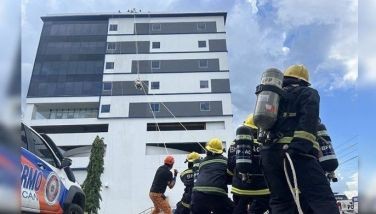Promises of prosperity

The city of Pasay stands on the brink of a remarkable transformation. That is, if the promises to redefine its skyline and elevate lands could unlock its economic potentials. Taking these tasks to achieve this vision is former congresswoman and now Pasay City Mayor Imelda Calixto-Rubiano. Supported by her brother, incumbent Pasay Congressman Tony Calixto, they endorsed the ambitious plans put forth by the Philippine Reclamation Authority (PRA) to transform the stretch of the Manila Bay – facing the Mall of Asia (MOA) – into a new frontier akin to Taiwan.
Why is it imperative for Pasay to reclaim more land? The answer lies in the city’s unique predicament. Despite being the fourth smallest city in Metro Manila, it bears the weight of the highest population density per capita. With approximately 26,315.79 persons crammed into each square kilometer of its mere 19-kilometer expanse, most of its interior areas are stiflingly congested.
There is simply not enough room for additional residential and commercial spaces to accommodate a population that has now exceeded half a million. This spatial scarcity stifles Pasay’s potential as a hub for investment and entertainment, a role it aspires to play on the national stage.
The city grapples with persistently high unemployment rates, straining its ability to provide crucial social services. In terms of development, the city of Pasay languishes at a disheartening 20 percent. It is third among highly urbanized cities, and ranks similarly in terms of accommodation capacity.
At present, government offices and other state-owned facilities occupy much of the available lands. This leaves limited room for public parks and recreational activities for the people. These amenities are what Pasayenos have yearned for through these years. It’s not for lack of resources that these desires remain unfulfilled. It is rather the simple fact that there’s just not enough space to maneuver.
The ongoing reclamation project in Pasay represents a bold undertaking. For one, it has met with both eager anticipation and cautious skepticisms. Nevertheless, it is imperative to acknowledge that the economic benefits of this endeavor must far outweigh the perceived risks. This is especially a major hurdle given the meticulous government regulations and laws in place to address environmental concerns.
With the use of cutting-edge reclamation technologies, the Pasay City reclamation project shines as a beacon of hope. This is not only for the local economic development of Pasay City but also for the Philippine economy to see further growth. It offers a multitude of advantages that could literally propel to brighter future.
At the center of this is the iconic Manila Bay sunset that it promised to preserve at its best focal point.
Critics have voiced their concerns regarding the potential environmental consequences of the Pasay reclamation project. It is crucial, however, to recognize that the implementation of modern reclamation technologies serve to mitigate these concerns.
Claims surrounding the environmental impact of reclamation projects frequently lack substantiated scientific basis. To make informed decisions, it is crucial to rely on credible studies and expert assessments rather than succumbing to unfounded fears. In the case of this project, the necessity for coastal defense against such unverified claims becomes evident.
By fortifying the reclamation project with robust scientific evidence, the government can continue its progress while upholding environmental stewardship. Independent environmental experts from here and abroad rigorously oversee the project in ensuring strict adherence to environmental standards and swift action in the face of such valid concerns.
As contained in its black and white contract with the national government, the project committed to adhere unwaveringly to rigorous environmental standards and incorporates sustainable design principles. The utilization of advanced technologies should ensure minimal disruptions to existing marine ecosystems. On the part of the city government of Pasay, they committed to preserving and rehabilitating natural habitats, safeguarding the environment for use and enjoyment of present up to future generations.
Pasay City has long grappled with flooding woes. This we have been seeing every time there is a typhoon. The reclamation initiatives include comprehensive flood mitigation measures in safeguarding both the reclaimed areas and existing communities. Thus, the usual flooding dissipates quickly during typhoons because of the improvements done in the reclaimed areas of the MOA.
The expansion of Pasay City will meaningfully augment its local government revenues. This will bring needed funds into essential services like healthcare, education and local infrastructure development needs laid out by Mayor Calixto-Rubiano.
This venture is reportedly set to generate tens of thousands of jobs, catering to a diverse range of Filipino workers, from skilled professionals to diligent laborers. In a post-pandemic landscape, these new employment prospects serve as a vital lifeline for countless families.
The infrastructure within the reclamation area promises improved connectivity across Metro Manila. This translates to reduced travel times, eased traffic congestion and heightened overall efficiency.
Pasay’s strategic location positions it as a magnet for international tourists and businesses alike. With the introduction of fresh reclamation zones, the city can accommodate an array of hotels, convention centers and trade facilities, positioning itself as a global epicenter for tourism and commerce.
However, the other non-compliant reclamation projects around the Manila Bay have unfairly dragged down the Pasay City project.
But by embracing state-of-the-art reclamation technologies and prioritizing environmental sustainability, this project is poised to reshape Pasay City for the better. No wonder the promises of prosperity and progress that the Pasay reclamation project holds is seen as within its grasp.
- Latest
- Trending
























